Masters Telecommunication: Enhancing 4G with MIMO/RF Path Analysis
VerifiedAdded on 2021/06/15
|11
|2873
|28
Report
AI Summary
This report reviews the application of massive MIMO/RF path technologies to address performance limitations in 4G networks, particularly in light of the increasing demands driven by IoT and bandwidth-intensive applications. It contrasts 4G LTE with emerging 5G technologies, evaluating the potential of MIMO to improve data throughput and spectral efficiency. The literature review covers various aspects of MIMO implementation, including transmit diversity, beamforming, and multi-cell CoMP, highlighting their advantages in enhancing network capacity and reducing latency. The report also discusses LTE-Advanced as a bridge between 4G and 5G, emphasizing key building blocks like carrier aggregation and heterogeneous networks. An evaluation section identifies research gaps, particularly concerning the cost and infrastructure requirements of 5G, as well as security and privacy issues. The conclusion underscores the importance of MIMO and OFDM technologies in achieving higher data throughput in LTE networks, summarizing the findings from the literature review and evaluation.
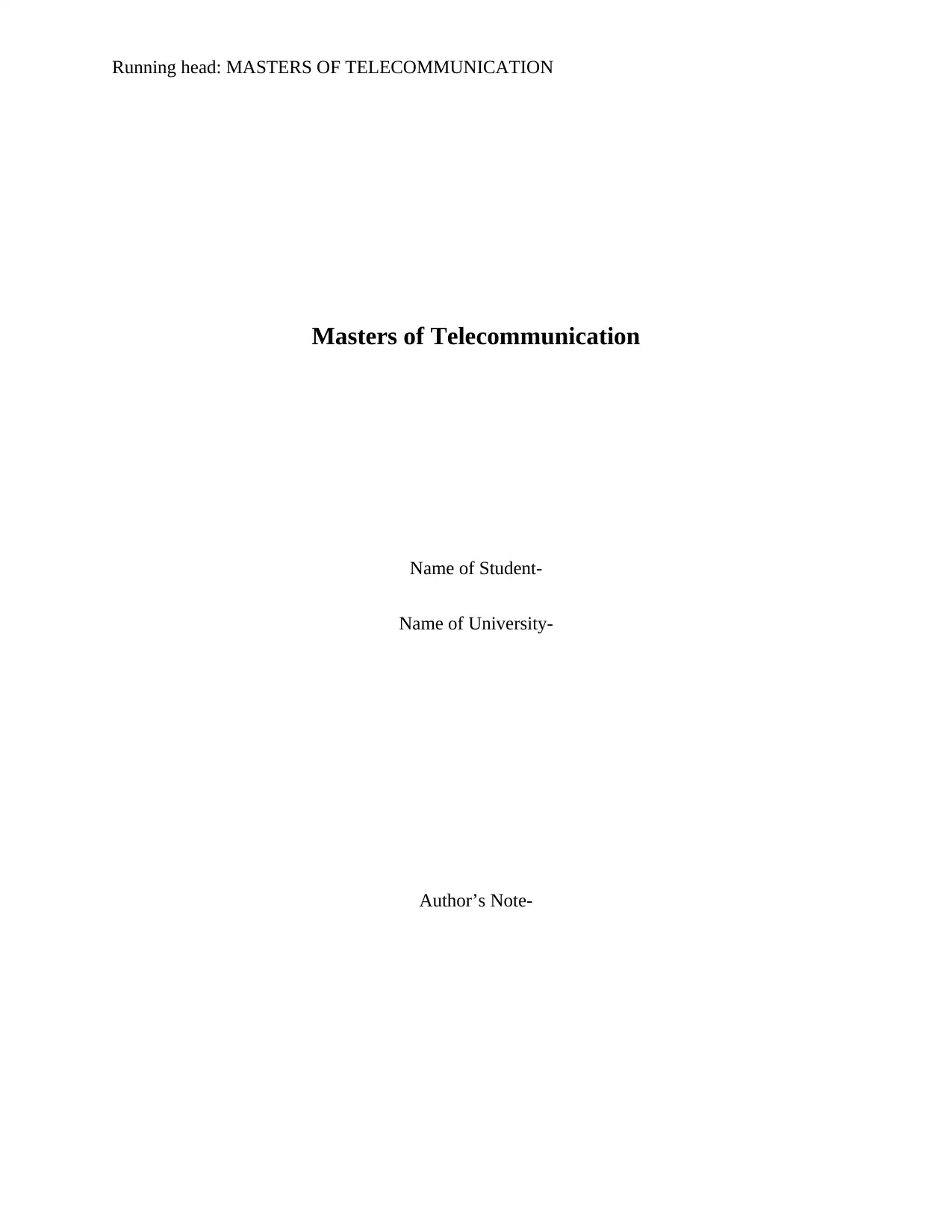
Running head: MASTERS OF TELECOMMUNICATION
Masters of Telecommunication
Name of Student-
Name of University-
Author’s Note-
Masters of Telecommunication
Name of Student-
Name of University-
Author’s Note-
Paraphrase This Document
Need a fresh take? Get an instant paraphrase of this document with our AI Paraphraser
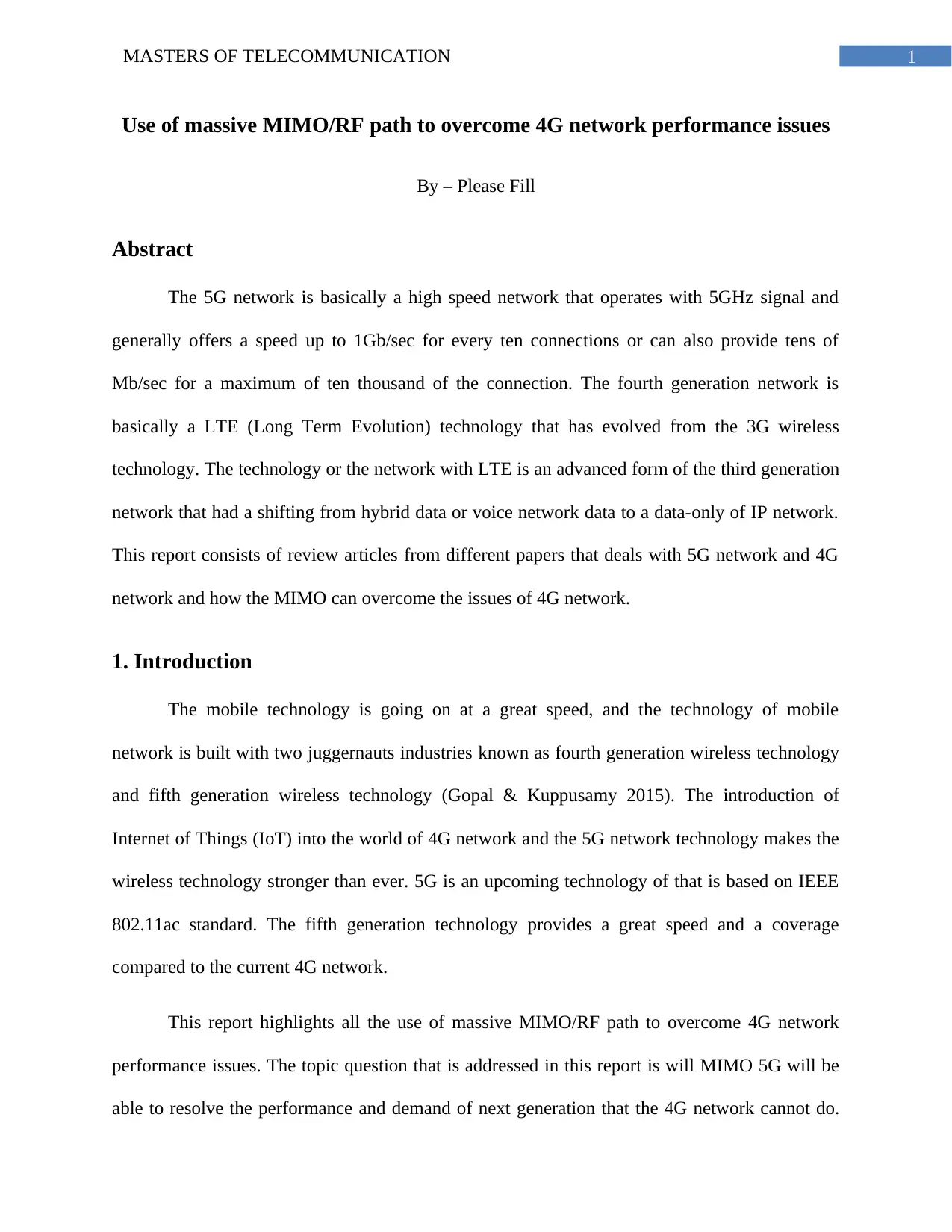
1MASTERS OF TELECOMMUNICATION
Use of massive MIMO/RF path to overcome 4G network performance issues
By – Please Fill
Abstract
The 5G network is basically a high speed network that operates with 5GHz signal and
generally offers a speed up to 1Gb/sec for every ten connections or can also provide tens of
Mb/sec for a maximum of ten thousand of the connection. The fourth generation network is
basically a LTE (Long Term Evolution) technology that has evolved from the 3G wireless
technology. The technology or the network with LTE is an advanced form of the third generation
network that had a shifting from hybrid data or voice network data to a data-only of IP network.
This report consists of review articles from different papers that deals with 5G network and 4G
network and how the MIMO can overcome the issues of 4G network.
1. Introduction
The mobile technology is going on at a great speed, and the technology of mobile
network is built with two juggernauts industries known as fourth generation wireless technology
and fifth generation wireless technology (Gopal & Kuppusamy 2015). The introduction of
Internet of Things (IoT) into the world of 4G network and the 5G network technology makes the
wireless technology stronger than ever. 5G is an upcoming technology of that is based on IEEE
802.11ac standard. The fifth generation technology provides a great speed and a coverage
compared to the current 4G network.
This report highlights all the use of massive MIMO/RF path to overcome 4G network
performance issues. The topic question that is addressed in this report is will MIMO 5G will be
able to resolve the performance and demand of next generation that the 4G network cannot do.
Use of massive MIMO/RF path to overcome 4G network performance issues
By – Please Fill
Abstract
The 5G network is basically a high speed network that operates with 5GHz signal and
generally offers a speed up to 1Gb/sec for every ten connections or can also provide tens of
Mb/sec for a maximum of ten thousand of the connection. The fourth generation network is
basically a LTE (Long Term Evolution) technology that has evolved from the 3G wireless
technology. The technology or the network with LTE is an advanced form of the third generation
network that had a shifting from hybrid data or voice network data to a data-only of IP network.
This report consists of review articles from different papers that deals with 5G network and 4G
network and how the MIMO can overcome the issues of 4G network.
1. Introduction
The mobile technology is going on at a great speed, and the technology of mobile
network is built with two juggernauts industries known as fourth generation wireless technology
and fifth generation wireless technology (Gopal & Kuppusamy 2015). The introduction of
Internet of Things (IoT) into the world of 4G network and the 5G network technology makes the
wireless technology stronger than ever. 5G is an upcoming technology of that is based on IEEE
802.11ac standard. The fifth generation technology provides a great speed and a coverage
compared to the current 4G network.
This report highlights all the use of massive MIMO/RF path to overcome 4G network
performance issues. The topic question that is addressed in this report is will MIMO 5G will be
able to resolve the performance and demand of next generation that the 4G network cannot do.
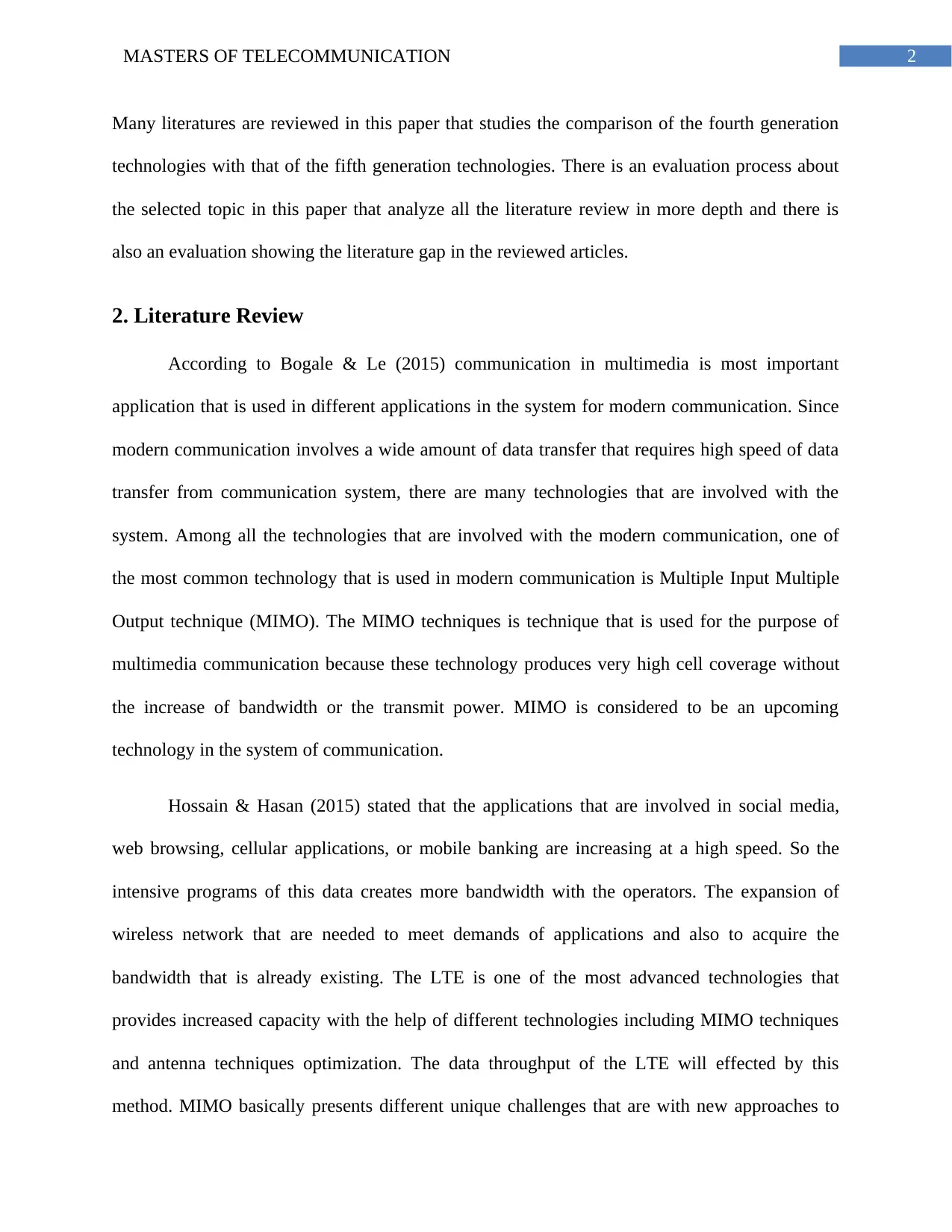
2MASTERS OF TELECOMMUNICATION
Many literatures are reviewed in this paper that studies the comparison of the fourth generation
technologies with that of the fifth generation technologies. There is an evaluation process about
the selected topic in this paper that analyze all the literature review in more depth and there is
also an evaluation showing the literature gap in the reviewed articles.
2. Literature Review
According to Bogale & Le (2015) communication in multimedia is most important
application that is used in different applications in the system for modern communication. Since
modern communication involves a wide amount of data transfer that requires high speed of data
transfer from communication system, there are many technologies that are involved with the
system. Among all the technologies that are involved with the modern communication, one of
the most common technology that is used in modern communication is Multiple Input Multiple
Output technique (MIMO). The MIMO techniques is technique that is used for the purpose of
multimedia communication because these technology produces very high cell coverage without
the increase of bandwidth or the transmit power. MIMO is considered to be an upcoming
technology in the system of communication.
Hossain & Hasan (2015) stated that the applications that are involved in social media,
web browsing, cellular applications, or mobile banking are increasing at a high speed. So the
intensive programs of this data creates more bandwidth with the operators. The expansion of
wireless network that are needed to meet demands of applications and also to acquire the
bandwidth that is already existing. The LTE is one of the most advanced technologies that
provides increased capacity with the help of different technologies including MIMO techniques
and antenna techniques optimization. The data throughput of the LTE will effected by this
method. MIMO basically presents different unique challenges that are with new approaches to
Many literatures are reviewed in this paper that studies the comparison of the fourth generation
technologies with that of the fifth generation technologies. There is an evaluation process about
the selected topic in this paper that analyze all the literature review in more depth and there is
also an evaluation showing the literature gap in the reviewed articles.
2. Literature Review
According to Bogale & Le (2015) communication in multimedia is most important
application that is used in different applications in the system for modern communication. Since
modern communication involves a wide amount of data transfer that requires high speed of data
transfer from communication system, there are many technologies that are involved with the
system. Among all the technologies that are involved with the modern communication, one of
the most common technology that is used in modern communication is Multiple Input Multiple
Output technique (MIMO). The MIMO techniques is technique that is used for the purpose of
multimedia communication because these technology produces very high cell coverage without
the increase of bandwidth or the transmit power. MIMO is considered to be an upcoming
technology in the system of communication.
Hossain & Hasan (2015) stated that the applications that are involved in social media,
web browsing, cellular applications, or mobile banking are increasing at a high speed. So the
intensive programs of this data creates more bandwidth with the operators. The expansion of
wireless network that are needed to meet demands of applications and also to acquire the
bandwidth that is already existing. The LTE is one of the most advanced technologies that
provides increased capacity with the help of different technologies including MIMO techniques
and antenna techniques optimization. The data throughput of the LTE will effected by this
method. MIMO basically presents different unique challenges that are with new approaches to
⊘ This is a preview!⊘
Do you want full access?
Subscribe today to unlock all pages.

Trusted by 1+ million students worldwide
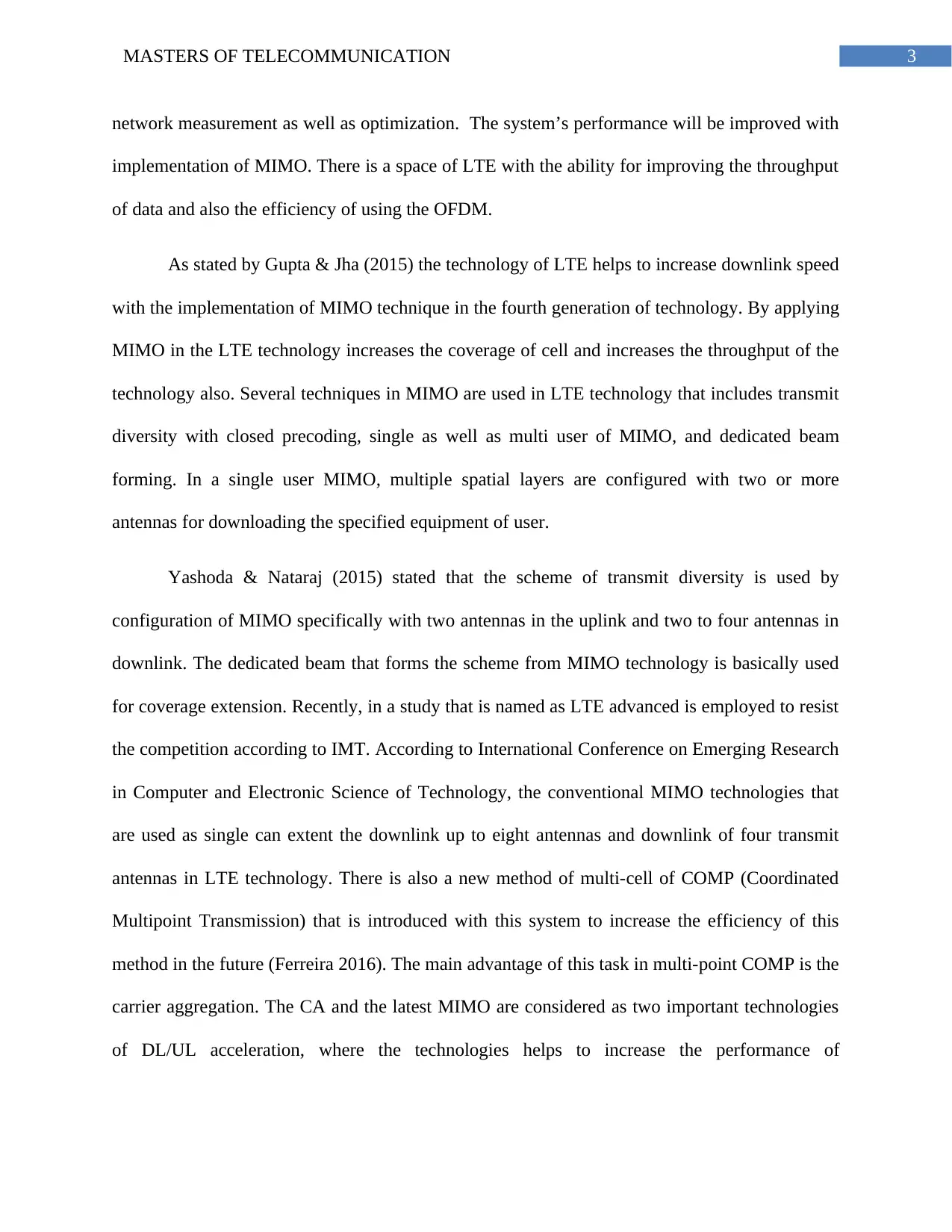
3MASTERS OF TELECOMMUNICATION
network measurement as well as optimization. The system’s performance will be improved with
implementation of MIMO. There is a space of LTE with the ability for improving the throughput
of data and also the efficiency of using the OFDM.
As stated by Gupta & Jha (2015) the technology of LTE helps to increase downlink speed
with the implementation of MIMO technique in the fourth generation of technology. By applying
MIMO in the LTE technology increases the coverage of cell and increases the throughput of the
technology also. Several techniques in MIMO are used in LTE technology that includes transmit
diversity with closed precoding, single as well as multi user of MIMO, and dedicated beam
forming. In a single user MIMO, multiple spatial layers are configured with two or more
antennas for downloading the specified equipment of user.
Yashoda & Nataraj (2015) stated that the scheme of transmit diversity is used by
configuration of MIMO specifically with two antennas in the uplink and two to four antennas in
downlink. The dedicated beam that forms the scheme from MIMO technology is basically used
for coverage extension. Recently, in a study that is named as LTE advanced is employed to resist
the competition according to IMT. According to International Conference on Emerging Research
in Computer and Electronic Science of Technology, the conventional MIMO technologies that
are used as single can extent the downlink up to eight antennas and downlink of four transmit
antennas in LTE technology. There is also a new method of multi-cell of COMP (Coordinated
Multipoint Transmission) that is introduced with this system to increase the efficiency of this
method in the future (Ferreira 2016). The main advantage of this task in multi-point COMP is the
carrier aggregation. The CA and the latest MIMO are considered as two important technologies
of DL/UL acceleration, where the technologies helps to increase the performance of
network measurement as well as optimization. The system’s performance will be improved with
implementation of MIMO. There is a space of LTE with the ability for improving the throughput
of data and also the efficiency of using the OFDM.
As stated by Gupta & Jha (2015) the technology of LTE helps to increase downlink speed
with the implementation of MIMO technique in the fourth generation of technology. By applying
MIMO in the LTE technology increases the coverage of cell and increases the throughput of the
technology also. Several techniques in MIMO are used in LTE technology that includes transmit
diversity with closed precoding, single as well as multi user of MIMO, and dedicated beam
forming. In a single user MIMO, multiple spatial layers are configured with two or more
antennas for downloading the specified equipment of user.
Yashoda & Nataraj (2015) stated that the scheme of transmit diversity is used by
configuration of MIMO specifically with two antennas in the uplink and two to four antennas in
downlink. The dedicated beam that forms the scheme from MIMO technology is basically used
for coverage extension. Recently, in a study that is named as LTE advanced is employed to resist
the competition according to IMT. According to International Conference on Emerging Research
in Computer and Electronic Science of Technology, the conventional MIMO technologies that
are used as single can extent the downlink up to eight antennas and downlink of four transmit
antennas in LTE technology. There is also a new method of multi-cell of COMP (Coordinated
Multipoint Transmission) that is introduced with this system to increase the efficiency of this
method in the future (Ferreira 2016). The main advantage of this task in multi-point COMP is the
carrier aggregation. The CA and the latest MIMO are considered as two important technologies
of DL/UL acceleration, where the technologies helps to increase the performance of
Paraphrase This Document
Need a fresh take? Get an instant paraphrase of this document with our AI Paraphraser
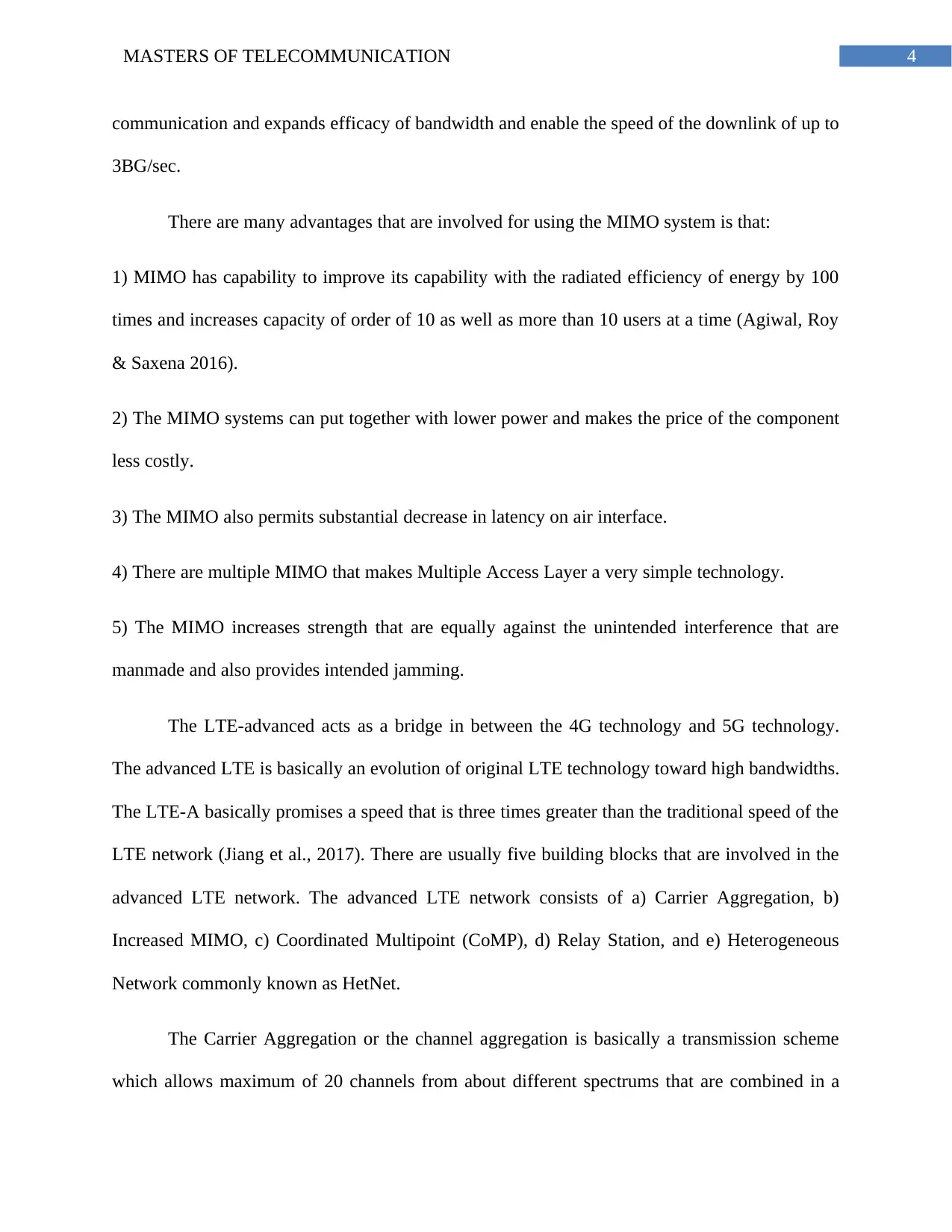
4MASTERS OF TELECOMMUNICATION
communication and expands efficacy of bandwidth and enable the speed of the downlink of up to
3BG/sec.
There are many advantages that are involved for using the MIMO system is that:
1) MIMO has capability to improve its capability with the radiated efficiency of energy by 100
times and increases capacity of order of 10 as well as more than 10 users at a time (Agiwal, Roy
& Saxena 2016).
2) The MIMO systems can put together with lower power and makes the price of the component
less costly.
3) The MIMO also permits substantial decrease in latency on air interface.
4) There are multiple MIMO that makes Multiple Access Layer a very simple technology.
5) The MIMO increases strength that are equally against the unintended interference that are
manmade and also provides intended jamming.
The LTE-advanced acts as a bridge in between the 4G technology and 5G technology.
The advanced LTE is basically an evolution of original LTE technology toward high bandwidths.
The LTE-A basically promises a speed that is three times greater than the traditional speed of the
LTE network (Jiang et al., 2017). There are usually five building blocks that are involved in the
advanced LTE network. The advanced LTE network consists of a) Carrier Aggregation, b)
Increased MIMO, c) Coordinated Multipoint (CoMP), d) Relay Station, and e) Heterogeneous
Network commonly known as HetNet.
The Carrier Aggregation or the channel aggregation is basically a transmission scheme
which allows maximum of 20 channels from about different spectrums that are combined in a
communication and expands efficacy of bandwidth and enable the speed of the downlink of up to
3BG/sec.
There are many advantages that are involved for using the MIMO system is that:
1) MIMO has capability to improve its capability with the radiated efficiency of energy by 100
times and increases capacity of order of 10 as well as more than 10 users at a time (Agiwal, Roy
& Saxena 2016).
2) The MIMO systems can put together with lower power and makes the price of the component
less costly.
3) The MIMO also permits substantial decrease in latency on air interface.
4) There are multiple MIMO that makes Multiple Access Layer a very simple technology.
5) The MIMO increases strength that are equally against the unintended interference that are
manmade and also provides intended jamming.
The LTE-advanced acts as a bridge in between the 4G technology and 5G technology.
The advanced LTE is basically an evolution of original LTE technology toward high bandwidths.
The LTE-A basically promises a speed that is three times greater than the traditional speed of the
LTE network (Jiang et al., 2017). There are usually five building blocks that are involved in the
advanced LTE network. The advanced LTE network consists of a) Carrier Aggregation, b)
Increased MIMO, c) Coordinated Multipoint (CoMP), d) Relay Station, and e) Heterogeneous
Network commonly known as HetNet.
The Carrier Aggregation or the channel aggregation is basically a transmission scheme
which allows maximum of 20 channels from about different spectrums that are combined in a
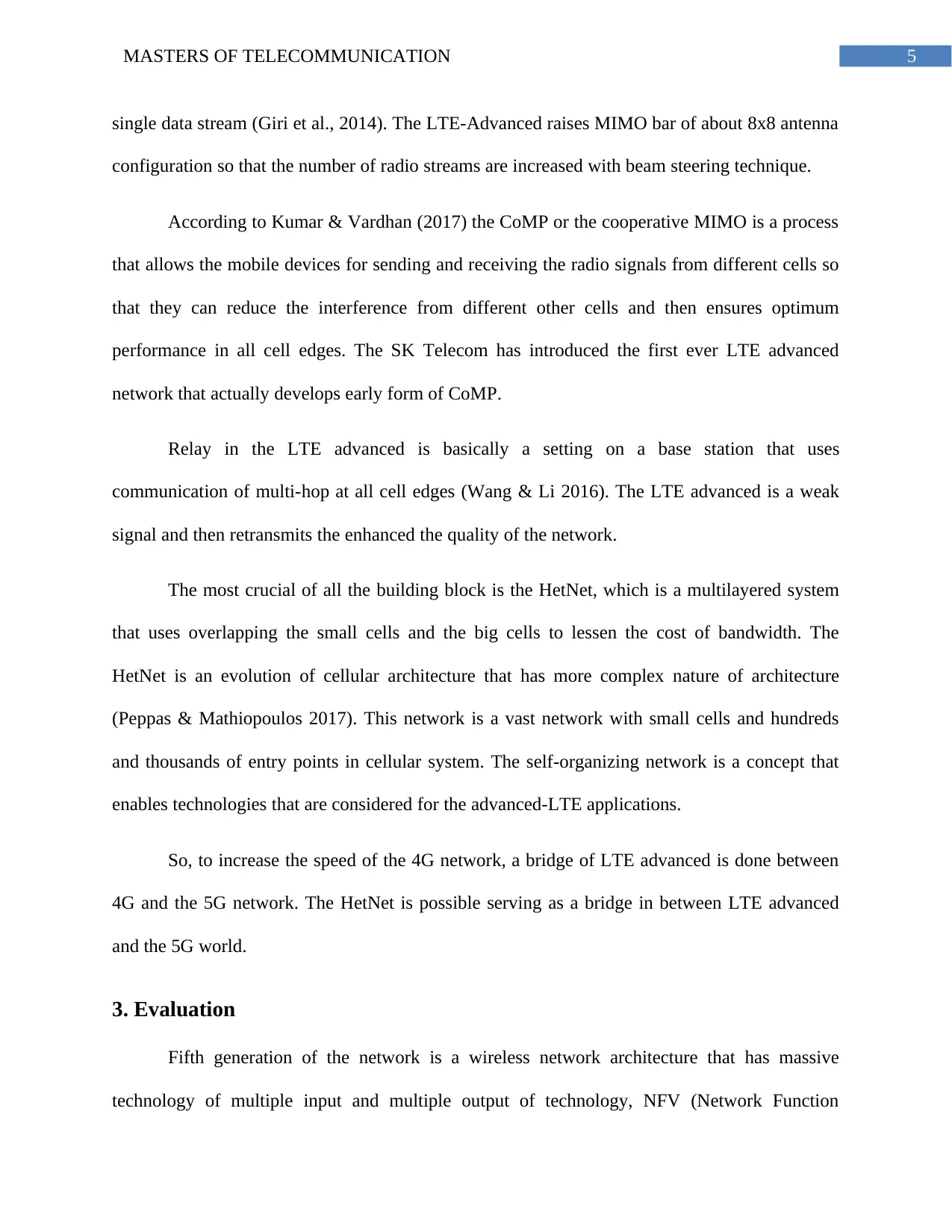
5MASTERS OF TELECOMMUNICATION
single data stream (Giri et al., 2014). The LTE-Advanced raises MIMO bar of about 8x8 antenna
configuration so that the number of radio streams are increased with beam steering technique.
According to Kumar & Vardhan (2017) the CoMP or the cooperative MIMO is a process
that allows the mobile devices for sending and receiving the radio signals from different cells so
that they can reduce the interference from different other cells and then ensures optimum
performance in all cell edges. The SK Telecom has introduced the first ever LTE advanced
network that actually develops early form of CoMP.
Relay in the LTE advanced is basically a setting on a base station that uses
communication of multi-hop at all cell edges (Wang & Li 2016). The LTE advanced is a weak
signal and then retransmits the enhanced the quality of the network.
The most crucial of all the building block is the HetNet, which is a multilayered system
that uses overlapping the small cells and the big cells to lessen the cost of bandwidth. The
HetNet is an evolution of cellular architecture that has more complex nature of architecture
(Peppas & Mathiopoulos 2017). This network is a vast network with small cells and hundreds
and thousands of entry points in cellular system. The self-organizing network is a concept that
enables technologies that are considered for the advanced-LTE applications.
So, to increase the speed of the 4G network, a bridge of LTE advanced is done between
4G and the 5G network. The HetNet is possible serving as a bridge in between LTE advanced
and the 5G world.
3. Evaluation
Fifth generation of the network is a wireless network architecture that has massive
technology of multiple input and multiple output of technology, NFV (Network Function
single data stream (Giri et al., 2014). The LTE-Advanced raises MIMO bar of about 8x8 antenna
configuration so that the number of radio streams are increased with beam steering technique.
According to Kumar & Vardhan (2017) the CoMP or the cooperative MIMO is a process
that allows the mobile devices for sending and receiving the radio signals from different cells so
that they can reduce the interference from different other cells and then ensures optimum
performance in all cell edges. The SK Telecom has introduced the first ever LTE advanced
network that actually develops early form of CoMP.
Relay in the LTE advanced is basically a setting on a base station that uses
communication of multi-hop at all cell edges (Wang & Li 2016). The LTE advanced is a weak
signal and then retransmits the enhanced the quality of the network.
The most crucial of all the building block is the HetNet, which is a multilayered system
that uses overlapping the small cells and the big cells to lessen the cost of bandwidth. The
HetNet is an evolution of cellular architecture that has more complex nature of architecture
(Peppas & Mathiopoulos 2017). This network is a vast network with small cells and hundreds
and thousands of entry points in cellular system. The self-organizing network is a concept that
enables technologies that are considered for the advanced-LTE applications.
So, to increase the speed of the 4G network, a bridge of LTE advanced is done between
4G and the 5G network. The HetNet is possible serving as a bridge in between LTE advanced
and the 5G world.
3. Evaluation
Fifth generation of the network is a wireless network architecture that has massive
technology of multiple input and multiple output of technology, NFV (Network Function
⊘ This is a preview!⊘
Do you want full access?
Subscribe today to unlock all pages.

Trusted by 1+ million students worldwide
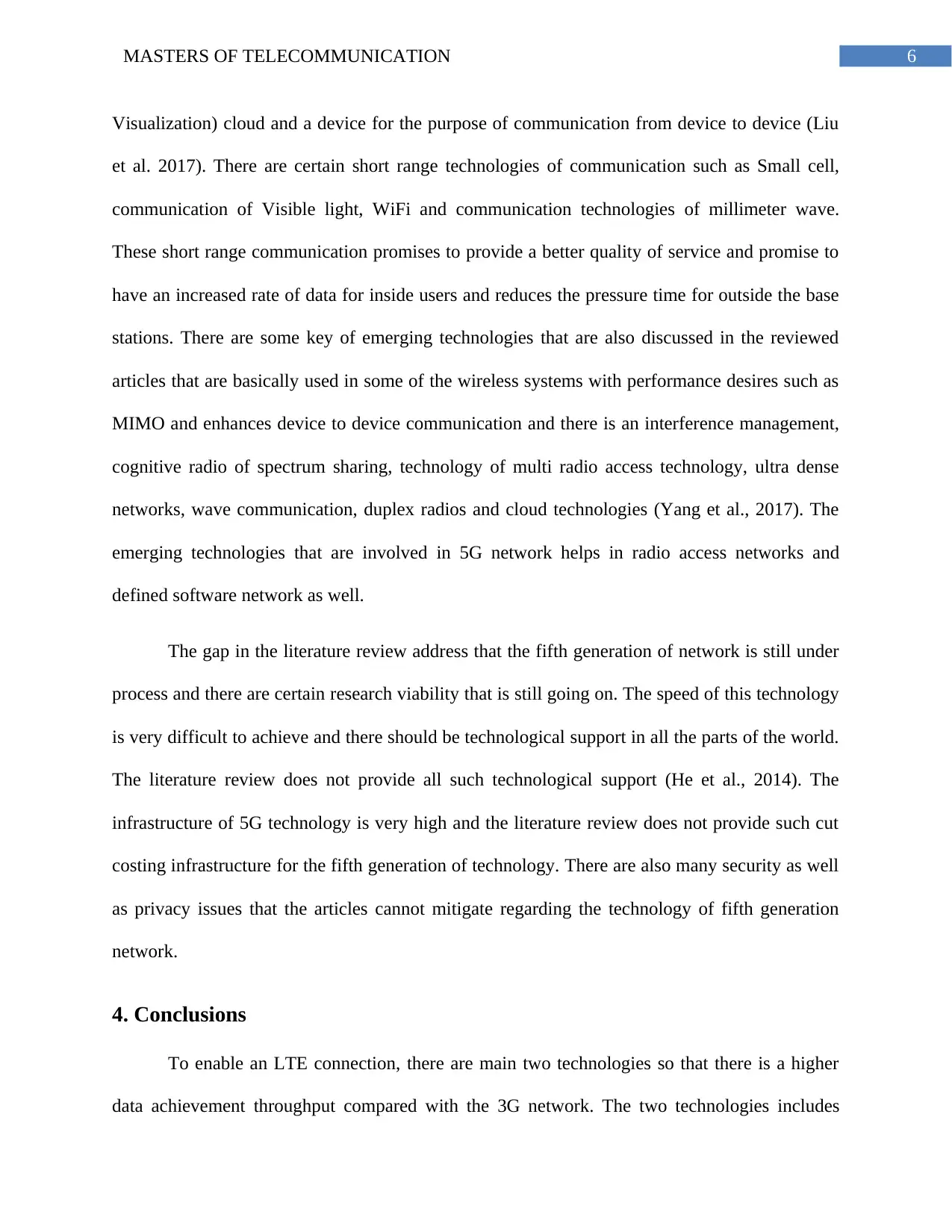
6MASTERS OF TELECOMMUNICATION
Visualization) cloud and a device for the purpose of communication from device to device (Liu
et al. 2017). There are certain short range technologies of communication such as Small cell,
communication of Visible light, WiFi and communication technologies of millimeter wave.
These short range communication promises to provide a better quality of service and promise to
have an increased rate of data for inside users and reduces the pressure time for outside the base
stations. There are some key of emerging technologies that are also discussed in the reviewed
articles that are basically used in some of the wireless systems with performance desires such as
MIMO and enhances device to device communication and there is an interference management,
cognitive radio of spectrum sharing, technology of multi radio access technology, ultra dense
networks, wave communication, duplex radios and cloud technologies (Yang et al., 2017). The
emerging technologies that are involved in 5G network helps in radio access networks and
defined software network as well.
The gap in the literature review address that the fifth generation of network is still under
process and there are certain research viability that is still going on. The speed of this technology
is very difficult to achieve and there should be technological support in all the parts of the world.
The literature review does not provide all such technological support (He et al., 2014). The
infrastructure of 5G technology is very high and the literature review does not provide such cut
costing infrastructure for the fifth generation of technology. There are also many security as well
as privacy issues that the articles cannot mitigate regarding the technology of fifth generation
network.
4. Conclusions
To enable an LTE connection, there are main two technologies so that there is a higher
data achievement throughput compared with the 3G network. The two technologies includes
Visualization) cloud and a device for the purpose of communication from device to device (Liu
et al. 2017). There are certain short range technologies of communication such as Small cell,
communication of Visible light, WiFi and communication technologies of millimeter wave.
These short range communication promises to provide a better quality of service and promise to
have an increased rate of data for inside users and reduces the pressure time for outside the base
stations. There are some key of emerging technologies that are also discussed in the reviewed
articles that are basically used in some of the wireless systems with performance desires such as
MIMO and enhances device to device communication and there is an interference management,
cognitive radio of spectrum sharing, technology of multi radio access technology, ultra dense
networks, wave communication, duplex radios and cloud technologies (Yang et al., 2017). The
emerging technologies that are involved in 5G network helps in radio access networks and
defined software network as well.
The gap in the literature review address that the fifth generation of network is still under
process and there are certain research viability that is still going on. The speed of this technology
is very difficult to achieve and there should be technological support in all the parts of the world.
The literature review does not provide all such technological support (He et al., 2014). The
infrastructure of 5G technology is very high and the literature review does not provide such cut
costing infrastructure for the fifth generation of technology. There are also many security as well
as privacy issues that the articles cannot mitigate regarding the technology of fifth generation
network.
4. Conclusions
To enable an LTE connection, there are main two technologies so that there is a higher
data achievement throughput compared with the 3G network. The two technologies includes
Paraphrase This Document
Need a fresh take? Get an instant paraphrase of this document with our AI Paraphraser
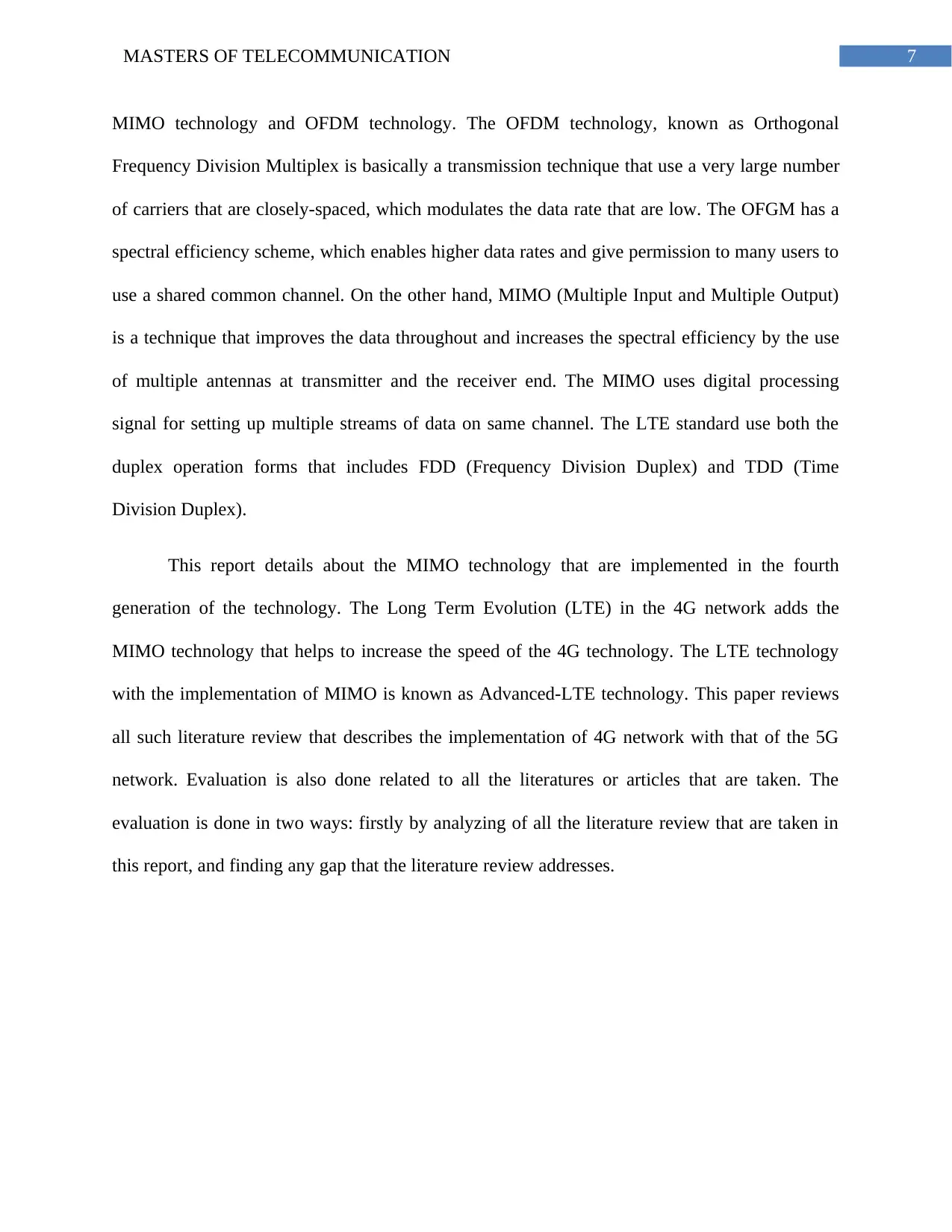
7MASTERS OF TELECOMMUNICATION
MIMO technology and OFDM technology. The OFDM technology, known as Orthogonal
Frequency Division Multiplex is basically a transmission technique that use a very large number
of carriers that are closely-spaced, which modulates the data rate that are low. The OFGM has a
spectral efficiency scheme, which enables higher data rates and give permission to many users to
use a shared common channel. On the other hand, MIMO (Multiple Input and Multiple Output)
is a technique that improves the data throughout and increases the spectral efficiency by the use
of multiple antennas at transmitter and the receiver end. The MIMO uses digital processing
signal for setting up multiple streams of data on same channel. The LTE standard use both the
duplex operation forms that includes FDD (Frequency Division Duplex) and TDD (Time
Division Duplex).
This report details about the MIMO technology that are implemented in the fourth
generation of the technology. The Long Term Evolution (LTE) in the 4G network adds the
MIMO technology that helps to increase the speed of the 4G technology. The LTE technology
with the implementation of MIMO is known as Advanced-LTE technology. This paper reviews
all such literature review that describes the implementation of 4G network with that of the 5G
network. Evaluation is also done related to all the literatures or articles that are taken. The
evaluation is done in two ways: firstly by analyzing of all the literature review that are taken in
this report, and finding any gap that the literature review addresses.
MIMO technology and OFDM technology. The OFDM technology, known as Orthogonal
Frequency Division Multiplex is basically a transmission technique that use a very large number
of carriers that are closely-spaced, which modulates the data rate that are low. The OFGM has a
spectral efficiency scheme, which enables higher data rates and give permission to many users to
use a shared common channel. On the other hand, MIMO (Multiple Input and Multiple Output)
is a technique that improves the data throughout and increases the spectral efficiency by the use
of multiple antennas at transmitter and the receiver end. The MIMO uses digital processing
signal for setting up multiple streams of data on same channel. The LTE standard use both the
duplex operation forms that includes FDD (Frequency Division Duplex) and TDD (Time
Division Duplex).
This report details about the MIMO technology that are implemented in the fourth
generation of the technology. The Long Term Evolution (LTE) in the 4G network adds the
MIMO technology that helps to increase the speed of the 4G technology. The LTE technology
with the implementation of MIMO is known as Advanced-LTE technology. This paper reviews
all such literature review that describes the implementation of 4G network with that of the 5G
network. Evaluation is also done related to all the literatures or articles that are taken. The
evaluation is done in two ways: firstly by analyzing of all the literature review that are taken in
this report, and finding any gap that the literature review addresses.
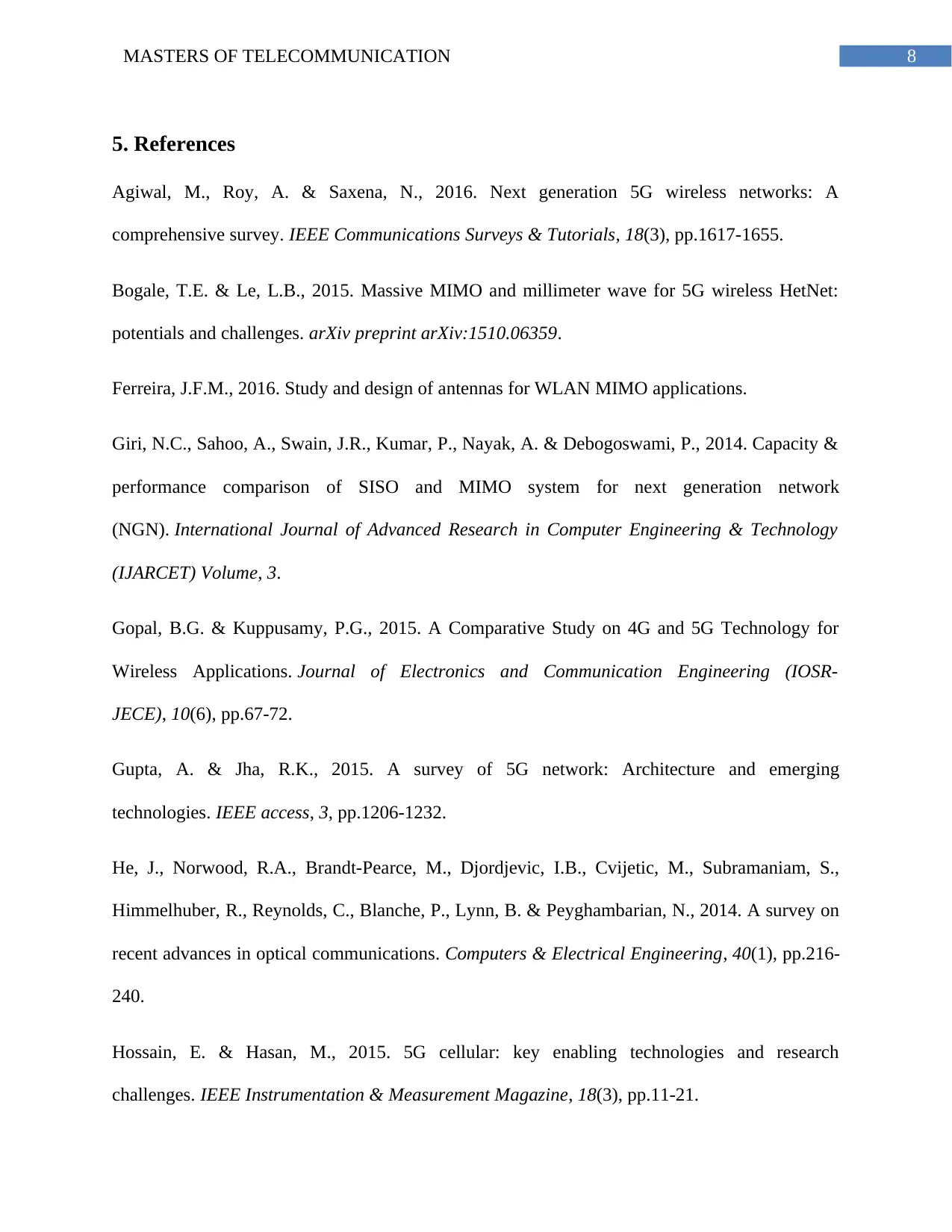
8MASTERS OF TELECOMMUNICATION
5. References
Agiwal, M., Roy, A. & Saxena, N., 2016. Next generation 5G wireless networks: A
comprehensive survey. IEEE Communications Surveys & Tutorials, 18(3), pp.1617-1655.
Bogale, T.E. & Le, L.B., 2015. Massive MIMO and millimeter wave for 5G wireless HetNet:
potentials and challenges. arXiv preprint arXiv:1510.06359.
Ferreira, J.F.M., 2016. Study and design of antennas for WLAN MIMO applications.
Giri, N.C., Sahoo, A., Swain, J.R., Kumar, P., Nayak, A. & Debogoswami, P., 2014. Capacity &
performance comparison of SISO and MIMO system for next generation network
(NGN). International Journal of Advanced Research in Computer Engineering & Technology
(IJARCET) Volume, 3.
Gopal, B.G. & Kuppusamy, P.G., 2015. A Comparative Study on 4G and 5G Technology for
Wireless Applications. Journal of Electronics and Communication Engineering (IOSR-
JECE), 10(6), pp.67-72.
Gupta, A. & Jha, R.K., 2015. A survey of 5G network: Architecture and emerging
technologies. IEEE access, 3, pp.1206-1232.
He, J., Norwood, R.A., Brandt-Pearce, M., Djordjevic, I.B., Cvijetic, M., Subramaniam, S.,
Himmelhuber, R., Reynolds, C., Blanche, P., Lynn, B. & Peyghambarian, N., 2014. A survey on
recent advances in optical communications. Computers & Electrical Engineering, 40(1), pp.216-
240.
Hossain, E. & Hasan, M., 2015. 5G cellular: key enabling technologies and research
challenges. IEEE Instrumentation & Measurement Magazine, 18(3), pp.11-21.
5. References
Agiwal, M., Roy, A. & Saxena, N., 2016. Next generation 5G wireless networks: A
comprehensive survey. IEEE Communications Surveys & Tutorials, 18(3), pp.1617-1655.
Bogale, T.E. & Le, L.B., 2015. Massive MIMO and millimeter wave for 5G wireless HetNet:
potentials and challenges. arXiv preprint arXiv:1510.06359.
Ferreira, J.F.M., 2016. Study and design of antennas for WLAN MIMO applications.
Giri, N.C., Sahoo, A., Swain, J.R., Kumar, P., Nayak, A. & Debogoswami, P., 2014. Capacity &
performance comparison of SISO and MIMO system for next generation network
(NGN). International Journal of Advanced Research in Computer Engineering & Technology
(IJARCET) Volume, 3.
Gopal, B.G. & Kuppusamy, P.G., 2015. A Comparative Study on 4G and 5G Technology for
Wireless Applications. Journal of Electronics and Communication Engineering (IOSR-
JECE), 10(6), pp.67-72.
Gupta, A. & Jha, R.K., 2015. A survey of 5G network: Architecture and emerging
technologies. IEEE access, 3, pp.1206-1232.
He, J., Norwood, R.A., Brandt-Pearce, M., Djordjevic, I.B., Cvijetic, M., Subramaniam, S.,
Himmelhuber, R., Reynolds, C., Blanche, P., Lynn, B. & Peyghambarian, N., 2014. A survey on
recent advances in optical communications. Computers & Electrical Engineering, 40(1), pp.216-
240.
Hossain, E. & Hasan, M., 2015. 5G cellular: key enabling technologies and research
challenges. IEEE Instrumentation & Measurement Magazine, 18(3), pp.11-21.
⊘ This is a preview!⊘
Do you want full access?
Subscribe today to unlock all pages.

Trusted by 1+ million students worldwide
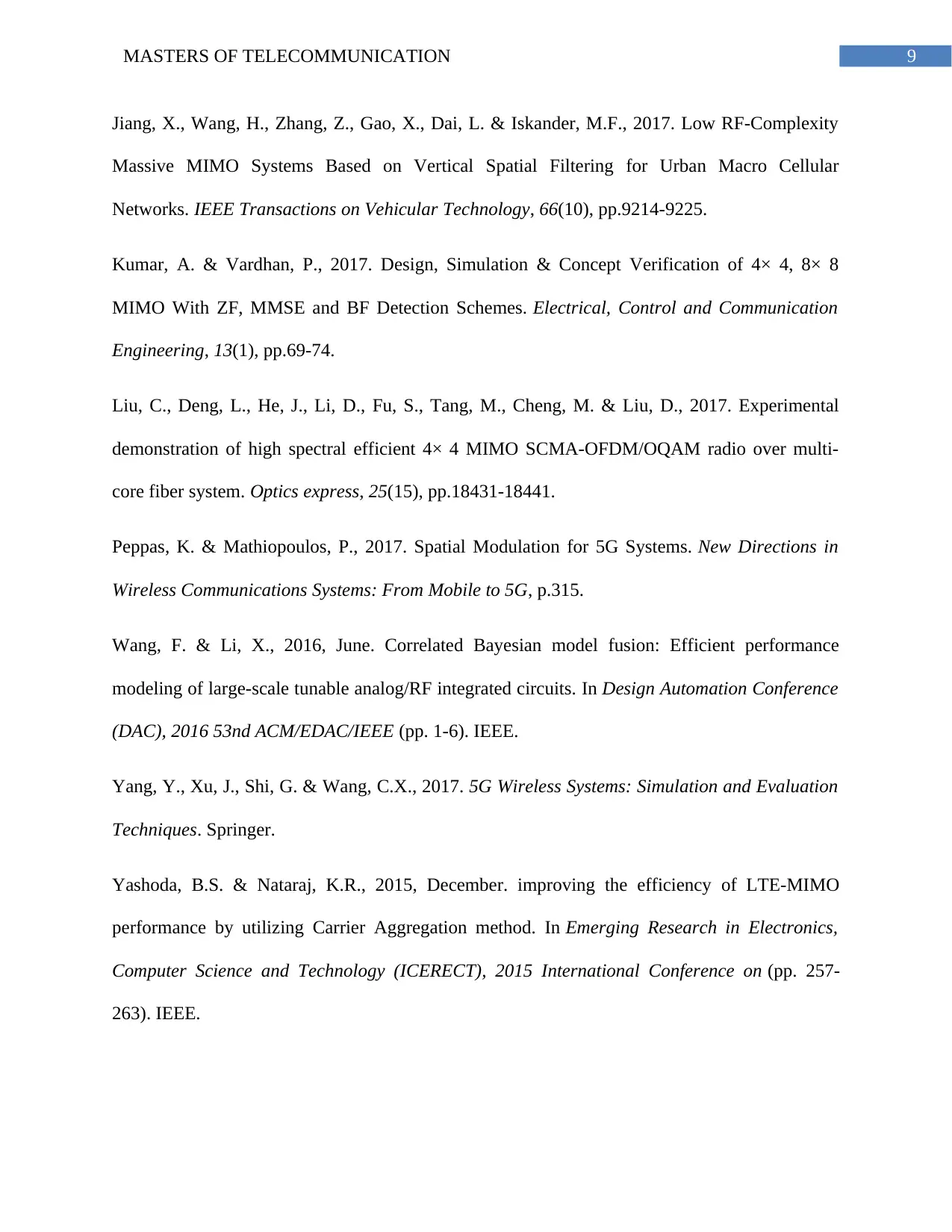
9MASTERS OF TELECOMMUNICATION
Jiang, X., Wang, H., Zhang, Z., Gao, X., Dai, L. & Iskander, M.F., 2017. Low RF-Complexity
Massive MIMO Systems Based on Vertical Spatial Filtering for Urban Macro Cellular
Networks. IEEE Transactions on Vehicular Technology, 66(10), pp.9214-9225.
Kumar, A. & Vardhan, P., 2017. Design, Simulation & Concept Verification of 4× 4, 8× 8
MIMO With ZF, MMSE and BF Detection Schemes. Electrical, Control and Communication
Engineering, 13(1), pp.69-74.
Liu, C., Deng, L., He, J., Li, D., Fu, S., Tang, M., Cheng, M. & Liu, D., 2017. Experimental
demonstration of high spectral efficient 4× 4 MIMO SCMA-OFDM/OQAM radio over multi-
core fiber system. Optics express, 25(15), pp.18431-18441.
Peppas, K. & Mathiopoulos, P., 2017. Spatial Modulation for 5G Systems. New Directions in
Wireless Communications Systems: From Mobile to 5G, p.315.
Wang, F. & Li, X., 2016, June. Correlated Bayesian model fusion: Efficient performance
modeling of large-scale tunable analog/RF integrated circuits. In Design Automation Conference
(DAC), 2016 53nd ACM/EDAC/IEEE (pp. 1-6). IEEE.
Yang, Y., Xu, J., Shi, G. & Wang, C.X., 2017. 5G Wireless Systems: Simulation and Evaluation
Techniques. Springer.
Yashoda, B.S. & Nataraj, K.R., 2015, December. improving the efficiency of LTE-MIMO
performance by utilizing Carrier Aggregation method. In Emerging Research in Electronics,
Computer Science and Technology (ICERECT), 2015 International Conference on (pp. 257-
263). IEEE.
Jiang, X., Wang, H., Zhang, Z., Gao, X., Dai, L. & Iskander, M.F., 2017. Low RF-Complexity
Massive MIMO Systems Based on Vertical Spatial Filtering for Urban Macro Cellular
Networks. IEEE Transactions on Vehicular Technology, 66(10), pp.9214-9225.
Kumar, A. & Vardhan, P., 2017. Design, Simulation & Concept Verification of 4× 4, 8× 8
MIMO With ZF, MMSE and BF Detection Schemes. Electrical, Control and Communication
Engineering, 13(1), pp.69-74.
Liu, C., Deng, L., He, J., Li, D., Fu, S., Tang, M., Cheng, M. & Liu, D., 2017. Experimental
demonstration of high spectral efficient 4× 4 MIMO SCMA-OFDM/OQAM radio over multi-
core fiber system. Optics express, 25(15), pp.18431-18441.
Peppas, K. & Mathiopoulos, P., 2017. Spatial Modulation for 5G Systems. New Directions in
Wireless Communications Systems: From Mobile to 5G, p.315.
Wang, F. & Li, X., 2016, June. Correlated Bayesian model fusion: Efficient performance
modeling of large-scale tunable analog/RF integrated circuits. In Design Automation Conference
(DAC), 2016 53nd ACM/EDAC/IEEE (pp. 1-6). IEEE.
Yang, Y., Xu, J., Shi, G. & Wang, C.X., 2017. 5G Wireless Systems: Simulation and Evaluation
Techniques. Springer.
Yashoda, B.S. & Nataraj, K.R., 2015, December. improving the efficiency of LTE-MIMO
performance by utilizing Carrier Aggregation method. In Emerging Research in Electronics,
Computer Science and Technology (ICERECT), 2015 International Conference on (pp. 257-
263). IEEE.
Paraphrase This Document
Need a fresh take? Get an instant paraphrase of this document with our AI Paraphraser

10MASTERS OF TELECOMMUNICATION
He, C., 2014. MIMO backscatter RFID systems: performance analysis, design and
comparison (Doctoral dissertation, University of British Columbia).
He, C., 2014. MIMO backscatter RFID systems: performance analysis, design and
comparison (Doctoral dissertation, University of British Columbia).
1 out of 11
Related Documents
Your All-in-One AI-Powered Toolkit for Academic Success.
+13062052269
info@desklib.com
Available 24*7 on WhatsApp / Email
![[object Object]](/_next/static/media/star-bottom.7253800d.svg)
Unlock your academic potential
Copyright © 2020–2025 A2Z Services. All Rights Reserved. Developed and managed by ZUCOL.




